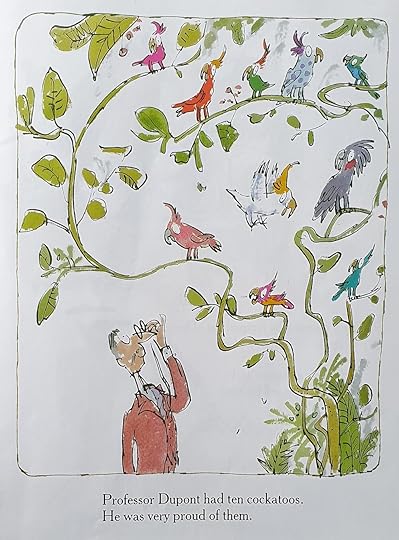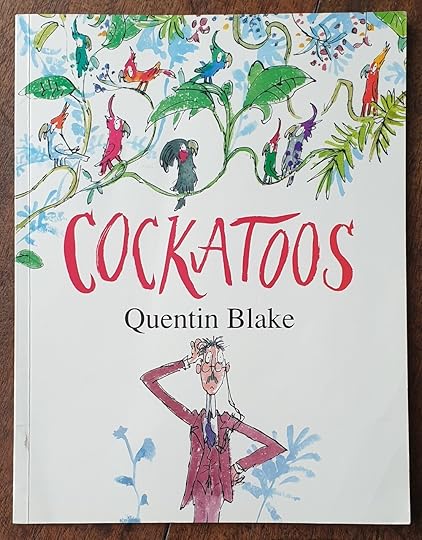Counting cockatoos with Quentin Blake

From Cockatoos by Quentin Blake (Jonathan Cape 1992) | © 1992 by Quentin Blake
Things are not always as they seem; the first appearance deceives many.
— Phaedrus
Whenever I go to a zoo, I always make sure I visit the tropical house.
The very best act as giant aviaries, with free-flying tropical birds, squeaking and squawking, sneaking about in the lush undergrowth. And I always think to myself: This would make a fantastic studio!

Sketchbook: Tropical house, Chester Zoo | © 2017 by Tim Warnes
My Good to Read recommendation this week features just such a glorious aviary-come-glasshouse - complete with an assortment of rather cheeky parrots! It’s the wonderful Cockatoos (Jonathan Cape 1992), by the inaugral Children’s Laureate, Sir Quentin Blake.
Quentin Blake had long wanted to create a story, featuring a man and his troupe of cockatoos. Blake finally found inspiration while house hunting in France, where he came across an old, rambling, run-down Gite. ‘There was a conservatory, the traditional cellar, an ancient stove with its long metal chimney,’ he recalls in Words and Pictures.
Enter Professor Dupont. Elderly, prim and proper (not unlike a slim Poirot). The professor has his daily routine: get washed and dressed (in a three-piece suit and tie), descend the staircase and greet the cockatoos living in his conservatory.

From Cockatoos by Quentin Blake (Jonathan Cape 1992) | © 1992 by Quentin Blake
Professor Dupont threw wide his arms.
… “Good morning, my fine feathered friends!”
Every morning he said the same thing.
The day came when the cockatoos thought they would go mad if they had to listen to the same words once again.
So the weary cockatoos - all ten of them - fly the coop (or rather, escape ‘through a broken pane of glass they had discovered in a corner of the conservatory’). And this is where the fun begins!
Where could all the cockatoos have got to?

From Cockatoos by Quentin Blake (Jonathan Cape 1992) | © 1992 by Quentin Blake
Blake’s simple tale suddenly morphs into a counting book - as well as a game of hide-and-seek! Professor Dupont searches every room of his elaborate, old house without spotting them—but readers will, for they’re all there, slightly concealed.
- Kirkus reviews
‘I normally leave out backgrounds if I don’t need them,’ explains Blake, ‘but in [Cockatoos] each spread is set in a different room of the house. I enjoyed drawing in all the French detail.’

From Cockatoos by Quentin Blake (Jonathan Cape 1992) | © 1992 by Quentin Blake
Blake’s illustrations are unmistakable (often copied but never matched). Joyfully drawn with apparent abandon, Blake himself has described them as “deceptively slapdash”. Deceptively is the keyword here, as anyone who has tried to handle watercolour and a dip pen will testify.
On visiting Blake’s studio, one journalist, observing Blake’s neatly arranged desk, notes that ‘there’s still an air of chaos hovering over his drawing board. A sense of exuberance waiting to be unleashed.’
That sense of exuberance is apparent in all Blake’s work - and Cockatoos is no exception.
Aside from the art, Cockatoos is a joy to read aloud! I like to give the professor a vaguely French-sounding accent, and relish the satisfying way in which his name - Professor Dupont - rolls off the tongue.

From Cockatoos by Quentin Blake (Jonathan Cape 1992) | © 1992 by Quentin Blake
Remember that old, French house which first inspired Blake?
“… [A]s I climbed the steep stairs to the grenier,” he explains in Words and Pictures, “there in front of me was a row of suitcases arranged, just as you see them in Cockatoos. All that was lacking was a cockatoo behind each.”
It’s one of my favourite spreads from the book, and I often talk about it when I visit schools.
Blake’s illustration both complements and contrasts with the text - and this is the book’s hidden superpower!
Let me explain.
Learning to read is hard for many, many children. They spend their early years being told what they can and can’t do, and must fit in with an adult’s timeframe.
So any opportunity for them to feel independent, smart, and in control is a healthy thing. Cockatoos does precisely that. Because it empowers children, giving them the satisfaction of reading a story for themselves, long before they can even recognise words.
‘The text is entirely from poor baffled Professor Dupont’s point of view,’ explains Blake. ‘[T]he written story hasn’t the first idea about the naughtiness that is going on in the pictures.’
[Professor Dupont] climbed a ladder and flashed his torch around the attic. They weren’t there.
But when you look closely - there are the escapees, hiding behind the cases! As the story progresses, each subsequent page turn reveals an additional cockatoo. Until finally, Professor Dupont is reunited with all ten of his feathered friends, who return the following day of their own free will. (Giving Blake the opportunity for one last little twist right at the very end...)

From Cockatoos by Quentin Blake (Jonathan Cape 1992) | © 1992 by Quentin Blake
This juxtaposition of two realities is absolutely critical to the story because it reveals something to the reader that they do not find in the text. ‘It is an old and useful tool in the picture book maker’s kit,’ says Blake, ‘and Cockatoos could not exist without it.’
Cockatoos is Good to Read because:‘As one friend put it to me: “When I read it to my son I am reading one story in the words and he is reading another story in the pictures.”’
- Words and Pictures by Quentin Blake
It’s funny!
No matter how many times you read it, there is always one cockatoo that is tricky to find…
You can have fun giving Professor Dupont a vaguely French-sounding accent!
It develops kids’ visual literacy skills.
It empowers young children - allowing them to experience the pleasure of reading a story for themselves.
It gives kids the satisfaction of getting one up on the adult, and contradicting their version of events!

‘There has never been, and probably never will be, a counting book as funny and
delightful as this’
- Books For Young ChildrenBuy UK
SourcesCockatoos by Quentin Blake (Jonathan Cape 1992) ‘Things are not always as they seem; the first appearance deceives many ’ by Phaedrus (brainyquote.com)Sketchbook by Tim Warnes (2017)Words and Pictures by Quentin Blake (Jonathan Cape 2000) Cockatoos by Quentin Blake (Kirkus.com, 1 Sept 1992) Interview with Quentin Blake (bl.uk, 21 Feb 2020)I never wanted children. But I do invent them: Interview with Quentin Blake by John Preston (The Telegraph Magazine, 04 Nov 2012) © 2020 BY TIM WARNES (UNLESS OTHERWISE ATTRIBUTED)****USE OF THIRD PARTY COPYRIGHTED MATERIAL FALLS UNDER FAIR USE/FAIR DEALING PRACTICE.
My Life in Books
For lovers of kid lit, this memoir - My Life in Books - is intended to give you the confidence and encouragement to share your own passion; to help you make lasting connections through kids’ books.
Originally posted at www.timwarnes.com ...more
- Tim Warnes's profile
- 30 followers



